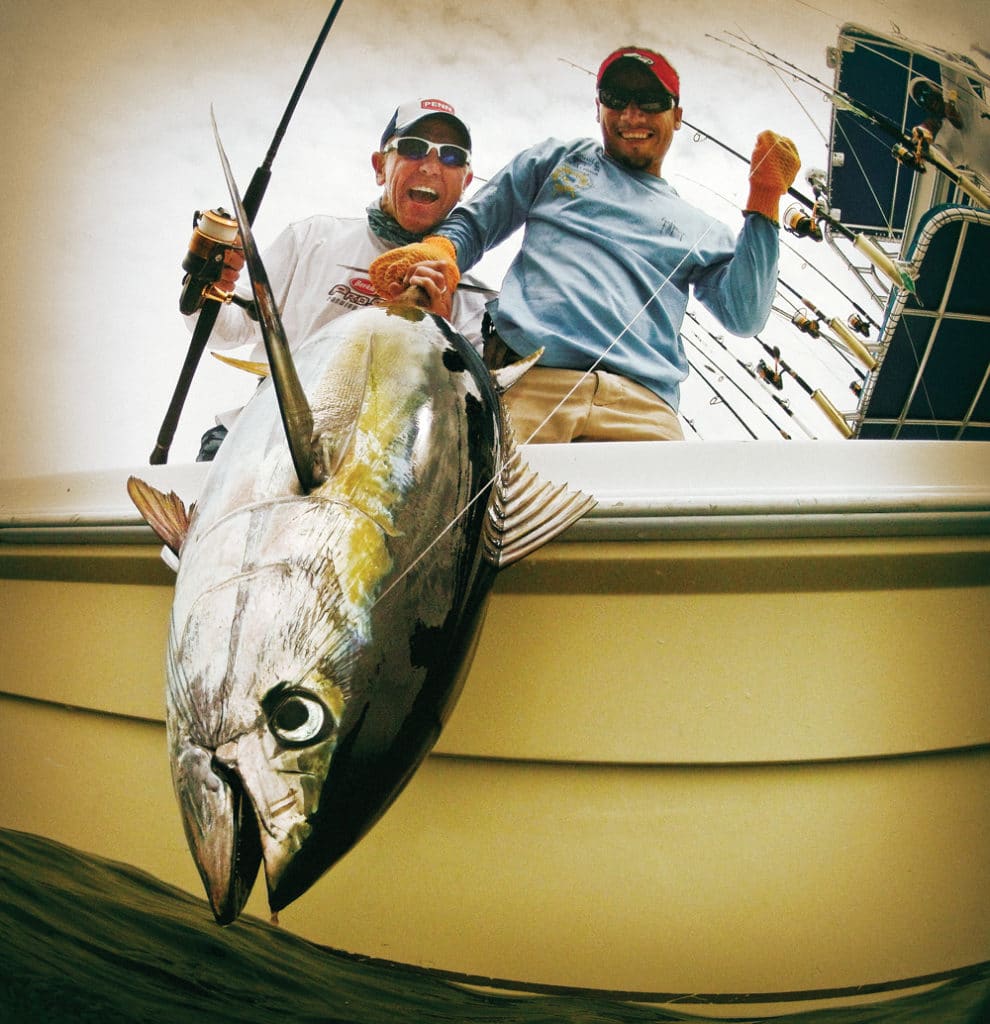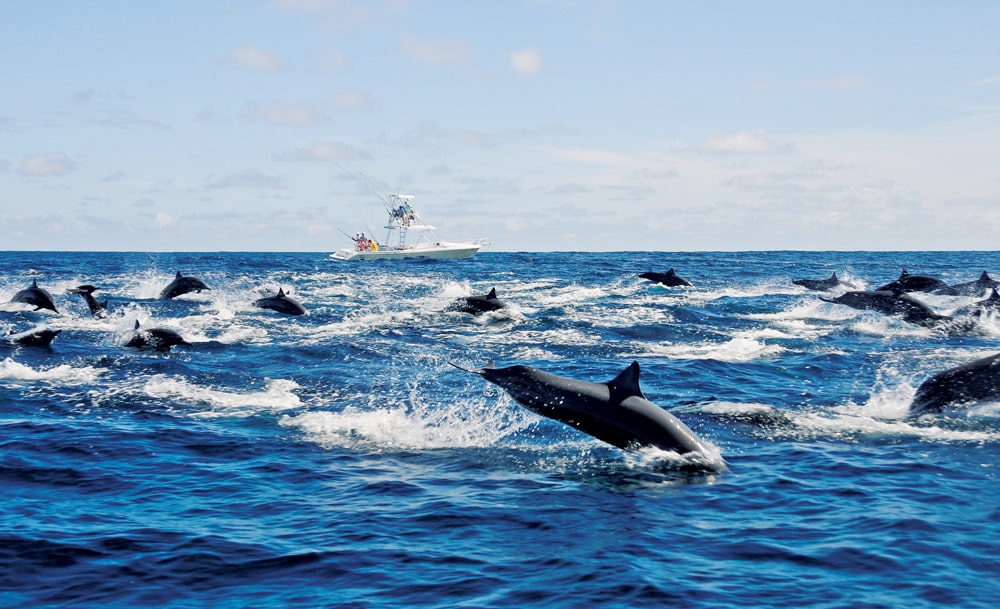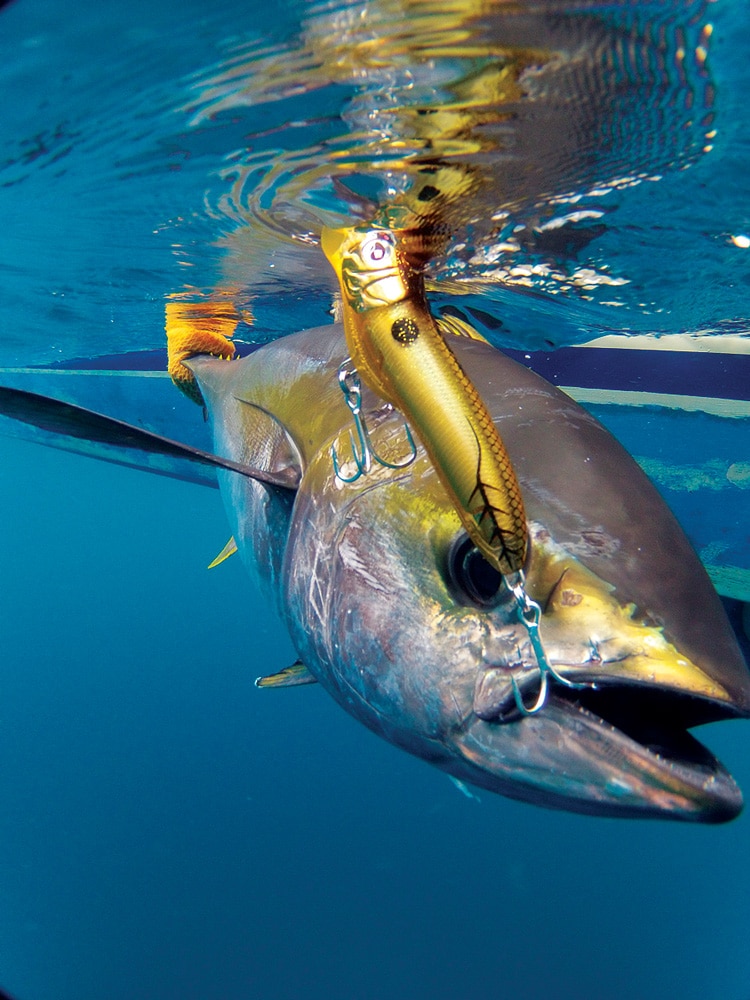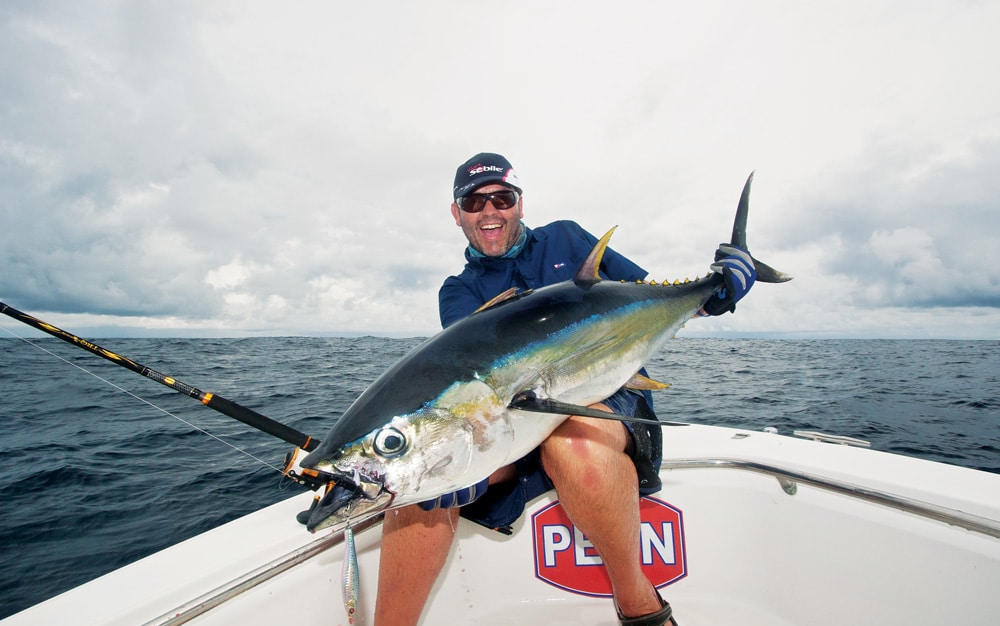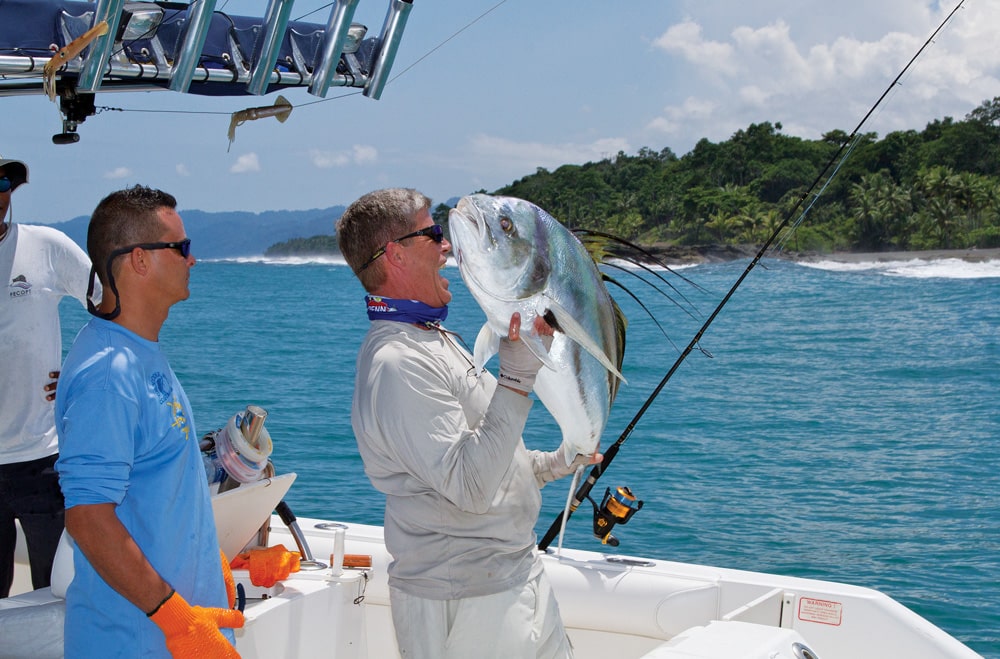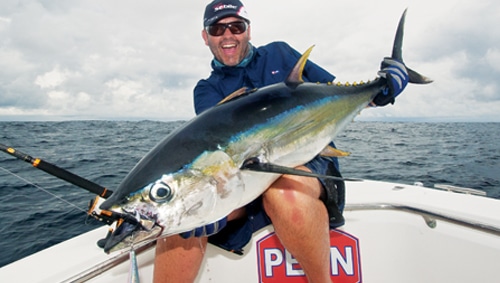
web_tout_CR
(Be sure to click through all the images in the gallery above.)
While there might be better ways to hook the really huge yellowfin tuna — as in 300-plus pounds — that patrol the eastern Pacific, I don’t think there could be any more-exciting way to hook any tuna than casting poppers into leaping, blitzing schools and cranking ’em back at high speed. The combination of the visuals (big yellowfin crashing your lure) and the physical (arm-wrenching strikes) definitely makes these “yee-haw!” moments.
That’s why, after a morning of little activity as we trolled, watched and waited 10 to 15 miles offshore of the lower Osa Peninsula off southern Costa Rica, we all jumped when the call came over the VHF. “Get those lines in!” Manfred, the mate aboard the Crocodile Bay Resort‘s Strikefisher 33, said. “They’ve got dolphin pods about two miles north!”
He didn’t have to tell us twice.
Finding Flipper
We knew of the well-established association between pods of dolphin (as in porpoise, of course, and not dorado/mahi) and yellowfin. Find big numbers of dolphin, and you might find feeding tuna.
While that “might” loomed large, and there are no guarantees when fishing the Pacific, it always pays if dolphin are spotted to see if they are traveling with an escort of yellowfin.
Our skipper pushed the throttles ahead hard, while Manfred tied circle hooks to the end of a couple of outfits. Hunter Cole and I opted to go with large poppers. Cole, senior marketing manager for Pure Fishing, handed me a Penn Spinfisher V with 50-pound braided line and a Sebile Splasher. He armed himself with the same, and we headed up to the bow.

| |Many tourists in areas like Costa Rica are interested in whale watching. For those coming to fish offshore, it’s all about dolphin watching. Skippers sitting up on the bridge while under way are constantly on dolphin recon — particularly the right species of dolphin. Courtesy National Marine Fisheries Service (3)|
There was no mistaking the dolphins — the sleek, dark mammals as much out of the water as in it, leaping high into the air — as well as the birds wheeling in the area. At first, I saw no sign of tuna and grew disheartened, until we drew near enough to see the silver bullets exploding from the surface sporadically among the dolphin.
Wanting to avoid the frustration of throwing short, I forced myself to wait, heart pounding, as the boat eased closer. Cole heaved a Splasher into the fray and just after, my own Splasher was on the heels of his. I glimpsed a commotion behind Cole’s lure, and suddenly his rod arced and bounced as he yelled, “I’m on!” Shortly after, a detonation under my lure knocked it high out of the water. With shaking hands, I cranked the popper the rest of the way to the boat — and then grabbed my camera to record Cole’s battle.
In the company of several other resort boats, we spent at least the next couple of hours running and gunning, trying to stay on the dolphin and tuna, until the yellowfin left or perhaps went deep. Most anglers had hooked tuna in that time, and some had brought several fish to the boat.
Best of all is that running and gunning for tuna means nonstop activity: If you’re not actually hooked up, you’re casting into fish or standing on the bow, ready as the skipper gets you into position. There’s never a dull moment.
At least that’s true when the yellowfin are feeding. If the tuna bite among the moving dolphin turns off, it might be only a matter of time until the fish start whacking bait again. “I had an angler out who really wanted a tuna on his popper. We stayed with a load of dolphin for four hours before the tuna went on a feed,” says Todd Staley, the resort’s fishing director. “Just before sunset, he ended up boating the 180-pound yellowfin that slam-dunked his popper.”
Fast Cast with a Jig
Southern Costa Rica offers — as we saw — good hunting grounds for tuna on top. In fact, the eastern Pacific from Mexico south into at least Ecuador can mean prime run‑and‑gun tuna activity when the timing is right.
For Crocodile Bay boats, that tends to be a crapshoot. “You can catch tuna any day of the year, just not very predictably,” Staley says. “We may find yellowfin out there for weeks at a time but then not see any for just as long.”
While he says there really is no tuna season, run-and-gun fans might have their best shot at finding tuna feeding late spring and late fall, with the fish more numerous then, but also smaller, as school fish dominate.
An effective alternative to poppers, metal speed jigs also have the advantage of tremendous long-distance castability, and when breezing fish are moving very fast or happen to be particularly spooky, only out-of-the-ballpark casts will make it to ground zero.
I was reminded of this the next day while fishing with Patrick Sebile. The yellowfin were on top but not feeding with quite as much abandon as they had been the day before. Sebile opted to forgo the Splasher and instead tied on one of his Fast Cast metal jigs. He cranked it hard and fast so it skipped along the top, looking indeed like a baitfish trying frantically to escape.
His jig was slammed repeatedly, and I became an instant believer in small metal jigs for schooling tuna at the surface.
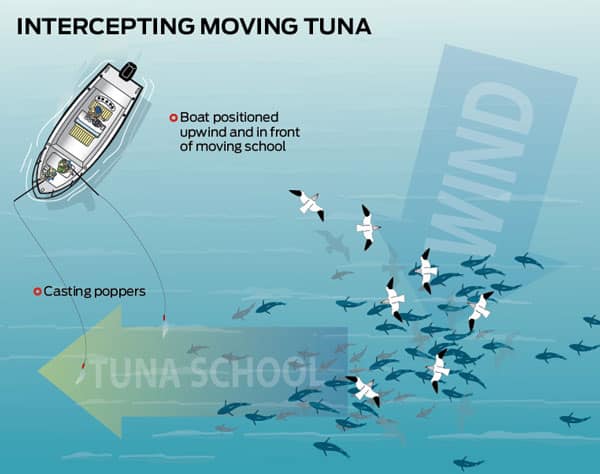
| |Dave Underwood|
Sails and Roosters
While fishing offshore of the Osa Peninsula can be a good bet for yellowfin, billfish are always a big blue-water draw. During our June visit, sails were few and far between — not such a surprise, since that’s usually a slow time for sails — but seasonally (January into May), sailfish can be swarming. Anglers after marlin have their best shots at black marlin and striped marlin in July, August and September, and blue marlin November through mid-January.
Plus, of course, this peninsula has earned a reputation for producing roosterfish. We tried our hand and weren’t disappointed. The beaches along the open southwestern Osa coast proved slow, but closer to the resort, around the southern tip of the peninsula, the default live bait — blue runners — found some willing takers. Roosters have a tough time passing up slow-trolled runners near shorelines, though they’re not shy about snatching up other live-bait offerings, such as a moonfish that the mate quickly bridled up and put over the side.
We spent some time jigging, but other than a Pacific red snapper, a bright-red scorpionfish and a small fortune jack, we couldn’t find a lot to show for our efforts. But I have seen photos of excellent jig catches.
As outstanding as the waters of southern Costa Rica can be for many species, I’ll take tuna on top any day for sheer adrenalin-pumping action.
Commercial Fishing: Successes and Setbacks
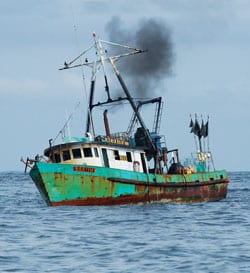
| |Doug Olander|
As is often the case these days, recreational-fishing interests in Costa Rica have enjoyed both successes and setbacks as far as commercial overfishing is concerned. Longliners, tuna seiners and shrimp trawlers have all posed problems. In the past year or two, large shrimpers have been working the coast around the Osa Peninsula hard, says Todd Staley. Licenses were issued without the requisite environmental-impact studies, Staley says, which is the crux of a pending lawsuit by a number of entities against shrimpers.
Some successes against longliners fishing nearshore (they are supposed to be operating at least 30 miles out) have produced impressive results, Staley says, but there are still problems, as with purse seiners, who can deplete a large area of yellowfin overnight. The Federacion Costarricense de Pesca (FECOP), the “sport-fishing and responsible-fishing lobby,” says Staley, is working to move the tuna seiners 200 miles offshore.
“FECOP is also working closely with the Minister of the Oceans, Jose Lino Chaves, who oversees activities in the ocean, including fishing,” Staley says. “He’s a no-nonsense guy and aggressively goes after lawbreakers. We had a problem with longliners illegally fishing live bait on their lines here for sailfish. He personally came down and pressed charges against 14 longline boats, and stayed on them until they gave up. The result has been some of the best fishing we have seen in years, with 15 to 30 fish in the spread a day more common than a rarity as in the past few years.”
Planning a Trip to Crocodile Bay
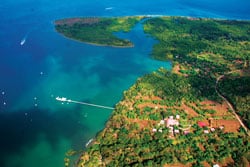
| |Courtesy Crocodile Bay Lodge|
Logistics: You’ll fly to San Jose, served by many international airlines, and then transfer to the nearby smaller regional airport for the 45-minute flight to Puerto Jimenez. (Note the 25-pound baggage limit unless other arrangements are made.) You might need to (and/or want to) overnight at a hotel in San Jose coming and/or going, depending upon time of year and local flight schedules.
Timing: Between offshore and inshore (Golfo Dulce) opportunities, any month of the year might offer good fishing. Some of the best months for billfish and tuna are noted in the text of this feature. Summer can be intermittently rainy, but the heaviest rains usually hold off until October. December through April is generally dry and sunny, and can be breezy as well.
Besides fishing: The pristine rainforest covering the Osa Peninsula lends itself to a variety of activities that falls under the “eco-tour” umbrella. These include kayaking, surfing, snorkeling, rainforest hiking, canopy tours, zip lining, bird-watching, biking, horseback riding and so on. All this makes the destination an appealing one for the angler who wants to combine some serious fishing with a variety of family activities.
For more information or reservations: Visit Crocodile Bay Resort’s website; for general information, go to visitcostarica.com.
_To see more photos and exciting video from this trip, visit our Costa Rica Tuna Fishing channel._
